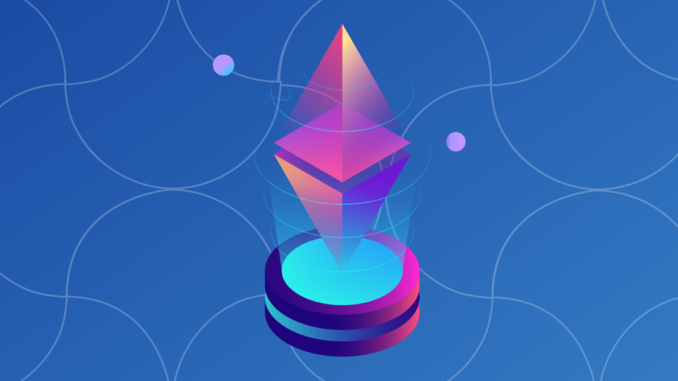

Ethereum is about to transition from a power-hungry, proof-of-work system to an environmentally friendly proof-of-stake system. This switch is known as the “merge,” and it’s coming soon. Here’s what you need to know.
What is the merge?
Ethereum will soon change the way transactions are validated. Currently, Ethereum works like Bitcoin: transactions are mined by a decentralized network of computers, which race to solve mathematical puzzles. They’re rewarded with new coins for doing so.
But this method, requiring computers to agree on which transactions will be added to a new block (proof of work), is very energy-intensive.
Ethereum will soon switch to a consensus mechanism called proof of stake, which uses far less power and should make the network about 99% more energy-efficient, according to figures from the Ethereum Foundation. Under proof of stake, transactions are confirmed by addresses that have staked—pledged to a smart contract—lots of ETH. Those who have staked more ETH earn proportionately higher rewards. While proof of stake conceptually makes the rich richer, it doesn’t boil the oceans, either.
The Ethereum community has been working on the transition to proof of stake ever since the blockchain launched in 2015.
The merge is one of a set of upgrades that should also make Ethereum faster and cheaper to use. Right now, Ethereum is beleaguered by slow transaction times and high costs. At peak congestion times, a simple swap on Uniswap for tokens worth $1 could cost you over $50 in transaction fees.
The merge itself won’t resolve high gas prices, however—it just sets the stage for a set of upgrades that will eventually cut costs. These upgrades used to be known as Ethereum 2.0, but that terminology was scrapped in early 2022.
Hasn’t Ethereum already switched to proof of stake?
You may have noticed that Ethereum already has a proof-of-stake chain, in which you can stake as much ETH as you like. That chain, known as the beacon chain, launched in December 2020. It’s been successful ever since its launch, and as of this writing has about 419,000 validators, who combined have staked about 13.4 million ETH, according to data from Nansen.
That beacon chain is neutered, however. It runs parallel to the main Ethereum blockchain and while developers are busy building the next version of Ethereum, you can’t do anything on it apart from stake ETH.
The merge will switch the mainnet version of Ethereum—the part that supports transactions and smart contracts—to be part of the beacon chain. Once the merge is complete, the proof-of-work part of Ethereum will fall away, and mining will be gone forever.
After the merge, you’ll eventually be able to run smart contracts on mainnet Ethereum using proof of stake rather than proof of work. You’ll also be able to withdraw any ETH you’ve staked on Ethereum 2.0. You won’t be able to do this right after the merge, however. You’ll have to wait for a post-merge “cleanup” upgrade, which the Ethereum Foundation—the organization that oversees the development of the Ethereum blockchain—expects will happen “very soon” after the merge.
When will the merge happen?
The Ethereum Foundation recently confirmed that the the mainnet chain will merge with the beacon chain sometime between September 10 and 20, depending on fluctuations in the network’s hash rate, which itself is a measure of computing power.
However, as Ethereum co-founder Vitalik Buterin reminded his Twitter followers on August 29, a crucial step in the process—the beacon chain hard fork—is scheduled to take place on September 6. So node operators are expected to upgrade their clients before this happens.
Reminder: even though the merge is coming around Sep 10-20, the beacon chain hard fork is on Sep 6. Make sure to update your clients before then! https://t.co/x8GQCbtNNk
— vitalik.eth (@VitalikButerin) August 30, 2022
Do you need to do anything?
Probably not. The merge won’t change anything about the history of Ethereum. You’ll still be able to head to block explorers like Etherscan to get a complete record of the Ethereum blockchain.
If everything goes smoothly, you won’t have to lift a finger—it’s all happening on the back end. But if you’re an active ETH trader on centralized exchanges, you’ll likely notice a temporary interruption in deposits and withdrawals. This is normal, and crypto exchanges such as Coinbase have already begun sending notices to customers to make sure they are aware.
And, of course, if you’re an Ethereum miner, you’ll be out of a job after the merge—you’ll have to mine somewhere else.
If you’re planning to stake ETH to the beacon chain (or, unless you have the 32 ETH necessary to run an Ethereum validator, delegate Ethereum to someone else), you might be happy to know that you can withdraw your ETH shortly after the merge. (You can already “withdraw” staked ETH through sites like Lido, which issue tokens that represent your staked ETH.)
One other thing: Once the merge occurs, the issuance of new Ethereum will reduce by about 90%. Ethereum’s issuance could even become deflationary if a lot of people use it.
What comes after the merge?
After the merge, subsequent upgrades will increase the capacity and speed of the network by introducing “shard chains.” These will expand the network to 64 blockchains. The merge needs to happen first because these shard chains rely on staking.
The Ethereum Foundation noted that the need for scaling through shard chains has been offset somewhat by layer-2 scaling solutions, like Optimism and Arbitrum.
Layer-2 scaling solutions temporarily transition ETH and ERC-20 tokens to another blockchain, which completes computational busywork for a fraction of the cost and at a far lower price.
Eventually, shards will likely coexist with layer-2 technologies. The Ethereum Foundation says that the need for “multiple rounds of shard chains” will be metered by the Ethereum community, but that it could provide “endless scalability.”
Editor’s note: This article was first published on April 13, 2022, and last updated on August 30.






Be the first to comment